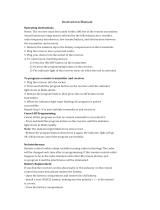
8
2.4 GHz Spectrum Overview
GLX-D operates within the 2.4GHz ISM band which is utilized by Wi-Fi, Bluetooth, and other wireless devices. The benefit of 2.4GHz is that it’s a global
band that can be used anywhere in the world, license free.
Overcoming the Challenges of 2.4GHz
The challenge of 2.4GHz is that Wi-Fi traffic can be
unpredictable. GLX-D meets these challenges in the
following ways:
• Prioritizes and transmits on the best 3
frequencies per channel (choosing from a pool
of 6 frequencies across the 2.4GHz band)
• Repeats the most important information such
that one frequency can be taken out entirely
without audio interruption
• Continuously scans during usage to rank
all frequencies (both current and backup
frequencies)
• Seamlessly moves away from interference to
backup frequencies without audio interruption
Coexisting with Wi-Fi
If you plan to use Wi-Fi during a perfor-
mance, turn on Wi-Fi devices prior to turn-
ing on GLX-D and scanning for the best
channel. GLX-D detects and avoids other
Wi-Fi traffic by scanning the entire 2.4GHz
environment and selecting the 3 best fre-
quencies to transmit on. The result of this is
reliable performance for your GLX-D wire-
less system as well as avoiding Wi-Fi trans-
missions which may be important as well.
“Bursting” Wi-Fi is harder to detect as it is
periodic; however, because GLX-D repeats
the most important information, even bursts
at very high-levels don’t have an effect on
your audio performance.
Challenging Wireless
Environments
Some environments are more difficult than
others for 2.4 GHz wireless system perfor-
mance. Additionally, body absorption has
a greater impact in the 2.4 GHz spectrum,
compared to the UHF spectrum. The simplest
solution in many cases is to reduce the trans-
mitter to receiver distance such as placing
the receivers on the stage with a clear line of
sight.
Challenging environments include:
• Areas with few reflective surfaces such
as:
• Outdoors
• Buildings with very high ceilings
• 3 or more GLX-D receivers in use
• Strong Wi-Fi presence
• Competitive 2.4 GHz systems in use
Note: Unlike analog TV band wireless which typically uses the same type of transmissions across manufacturers, all 2.4GHz wireless currently on the market use different
variations of wireless transmission. These differences make it more difficult to mix and match 2.4 GHz from multiple manufacturers successfully, as can be done with TV band
wireless solutions.
Tips to Improve Wireless System Performance
If you encounter interference or dropouts, try the following suggestions:
• Scan for the best available channel (press the channel button)
• Reduce transmitter to receiver distance - for example, place
receivers on stage with a line of sight to the receiver.
• Keep the transmitter and receiver more than 2 meters (6 feet) apart
• Locate competitive 2.4 GHz receivers away from each other
• Move receiver further away from Wi-Fi access points, computers, or
other active 2.4 GHz sources.
• Disable non-critical Wi-Fi on computers, cell phones, and other
portable devices
• If you plan to use Wi-Fi during a performance, turn on Wi-Fi prior to
turning on GLX-D and scanning for the best channel.
• Avoid heavy Wi-Fi traffic activities such as downloading large files or
viewing a movie.
2.4 GHz Frequency Tables
The following tables list receiver channels, frequencies, and latency for each group:
Group 1: Channels 1-4 (latency = 4.0 ms)
Group/Channel Frequencies
1/1 2424 2425 2442
2443 2462 2464
1/2 2418 2419 2448
2450 2469 2471
1/3 2411 2413 2430
2431 2476 2477
1/4 2405 2406 2436
2437 2455 2457
Group 2: Channels 1-5 (latency = 7.3 ms)
Group/Channel Frequencies
2/1 2423 2424 2443
2444 2473 2474
2/2 2404 2405 2426
2427 2456 2457
2/3 2410 2411 2431
2432 2448 2449
2/4 2417 2418 2451
2452 2468 2469
2/5 2437 2438 2462
2463 2477 2478
Group 3: Channels 1-8 (latency = 7.3 ms)
Group/Channel Frequencies
3/1 2415 2416 2443
3/2 2422 2423 2439
3/3 2426 2427 2457
3/4 2447 2448 2468
3/5 2409 2451 2452
3/6 2431 2462 2463
3/7 2404 2473 2474
3/8 2435 2477 2478
• Avoid placing transmitter and receiver where metal or other
dense materials may be present
• Keep transmitters more than 2 meters (6 feet) apart
Note: GLX-D transmitters closer than 6 inches (15 cm) to other non-GLX-D
transmitters may cause audible noise in that transmitter
• During sound check, mark trouble spots and ask presenters or
performers to avoid those areas
• If there is a known strong source of Wi-Fi and you specifically
want to use frequencies within that Wi-Fi channel, use the
following Group/Channel of GLX-D (best option listed first):
• Wi-Fi 1: Group 3/Channel 8, Group 3/Channel 4
• Wi-Fi 6: Group 3/Channel 7, Group 3/Channel 5
• Wi-Fi 11: Group 3/Channel 2, Group 3/Channel 1
















